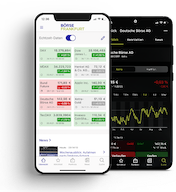Weekly outlook: “The DAX is expensive”

The German benchmark index is marching from one high to the next. However, analysts warn of increasing risks with regard to valuations.
10 June 2025. FRANKFURT (Börse Frankfurt). For five weeks in a row now, the DAX has managed to set a new all-time high each time. Last Thursday, the new record high was set at 24,479 points. That was the 30th all-time high in the current year. The German benchmark index ended the week up 1.3 percent at 24,304 points. The Stoxx Europe 600 gained 0.9 percent to 553.64 points. This is still around two percent below the high reached at the beginning of March. Since the correction low in April, the index has risen by “only” a good 19 percent, while the DAX gained 31 percent during this period. On Pentecost Monday, the DAX posted a small loss and closed at 24,174 points. It is still trading in this range this morning. The major US indices, the S&P 500 and Nasdaq 100, rose slightly at the beginning of the week. Asian stock markets are also looking positive on Tuesday.
Technical picture: Bollinger Bands as a guide
From a technical perspective, the ever-new record highs are fundamentally positive, as they mean that there are no longer any significant horizontal resistance levels. However, this does not necessarily mean that prices will continue to rise indefinitely. Jörg Scherer of HSBC has therefore been recommending for several days now that investors take a close look at the Bollinger Bands of the DAX. This volatility indicator has contracted significantly due to the “lack of movement in recent weeks,” which in the past has often been “the ideal breeding ground for a new volatility impulse,” i.e., a sharp rise in prices. In addition, the upper and lower Bollinger Bands (currently at 24,449 and 23,987 points, respectively) are currently coinciding with other important technical chart indicators. Therefore, a breakout in either direction could “certainly serve as a strategic guide.”
DAX with valuation problem
Many “traditional” analysts are currently rather skeptical about the stock markets. “The DAX is rushing from one high to the next as if the issue of tariffs were off the table. The risk of negative surprises is therefore greater than the chance that things will get even better,” warns Christian Apelt of Helaba. In recent weeks, investors have “anticipated a great deal of positive developments,” particularly with regard to the tariff issue. As a result, the DAX is now expensive by historical standards, and the valuation expansion is “not sufficiently supported by rising economic leading indicators.” Technically, too, the DAX looks “overheated.” An index level of a good 16 percent above the 200-day average has often led to corrections in previous phases. At the end of the year, the strategist expects the DAX to be in the region of 22,000 points, just below its current level.

Christian Apelt
MDAX and SDAX have an advantage in the long term
Sören Hettler from DZ Bank believes that the DAX has been “out of control for several months.” Not only the price-earnings ratio, but also other key indicators are now in the “expensive” range. This makes the German stock index particularly vulnerable to setbacks in the short term if “one of the numerous stumbling blocks” proves to be too big. However, the analyst also offers hope. In the long term, government investment programs will give the German stock market “structural tailwind.” He sees good opportunities for the MDAX and SDAX in particular, because the revenues of the companies represented here are more strongly focused on the German economy and the share of manufacturing is higher than in the DAX. “This is where investments in Germany's physical and digital infrastructure and the modernization of government institutions come into play.”
Important economic and business events this week
Tuesday, 10 June
10:30 a.m. Germany: sentix economic index. Following the extraordinary fluctuations of recent months, Deka strategists expect the sentix economic index for the eurozone to stabilize this time around. Stable positive surprises in economic indicators and robust stock markets should have led to a slight improvement in sentiment in June.
Wednesday, 11 June
2:30 p.m. USA: Consumer prices. According to Deka, the data for May will serve as an indication of when the first significant tariff-related price effects will become visible. While the overall rate is likely to be slowed by falling energy prices, the effects of tariffs should become more visible in prices excluding food and energy.
Thursday, 12 June
2:30 p.m. USA: Producer prices. Commerzbank analysts expect a return to “normality” after the surprisingly sharp decline in April. Specifically, the core rate is expected to have climbed by 0.3 percent compared to the previous month, giving the US Federal Reserve little reason to cut interest rates anytime soon.
Friday, 13 June
11:00 a.m. Eurozone: Industrial production. Following significant growth in March, Helaba strategists are now expecting a month-on-month decline of 1.3 per cent. This would represent an increase of 1.7 per cent for the year as a whole.
4:00 p.m. US: University of Michigan Consumer Sentiment Index. While the Conference Board survey recently signaled an improvement, particularly in expectations, economists surveyed by Commerzbank expect the index to remain essentially unchanged at 52 points.52 Punkten.
By Thomas Koch, 10 June 2025, © Deutsche Börse AG
About the author
Thomas Koch is a CEFA investment analyst, investment specialist for structured products, and certified certificate advisor. Since early 2006, he has been covering capital market events as a freelance journalist.
Feedback and questions to redaktion@deutsche-boerse.com





